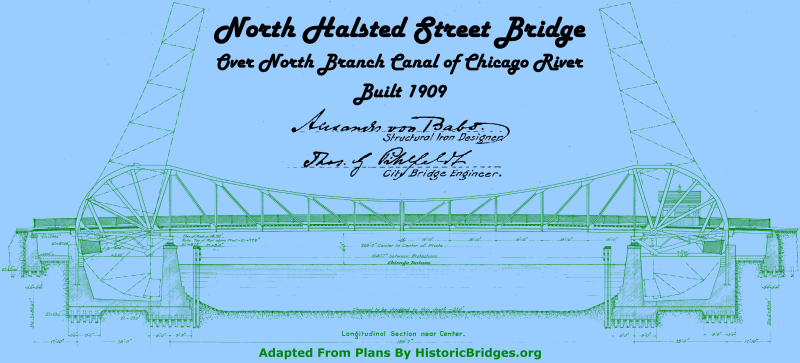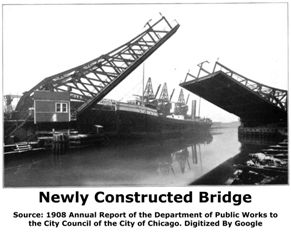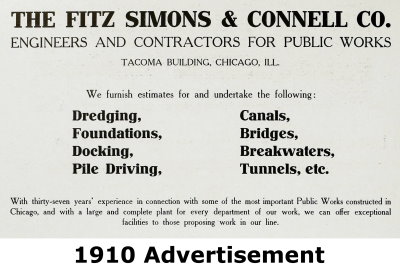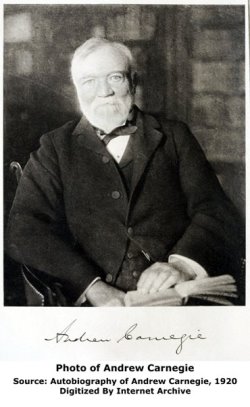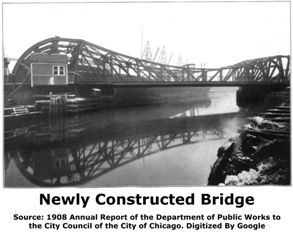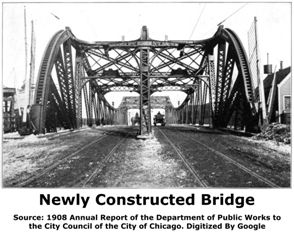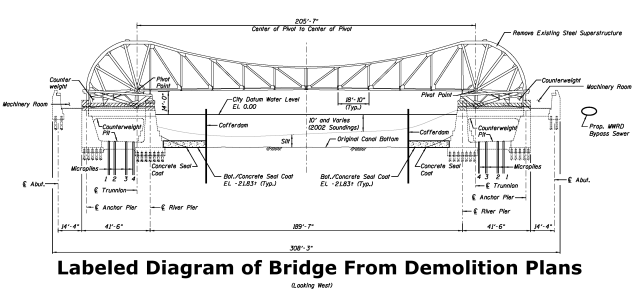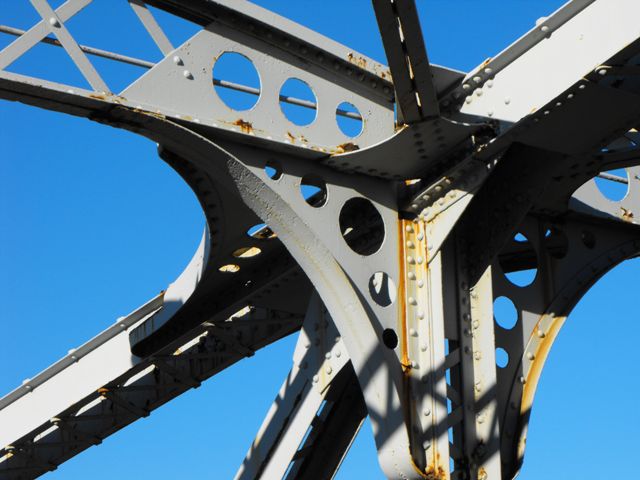We Recommend:
Bach Steel - Experts at historic truss bridge restoration.
Halsted Street North Branch Canal Bridge
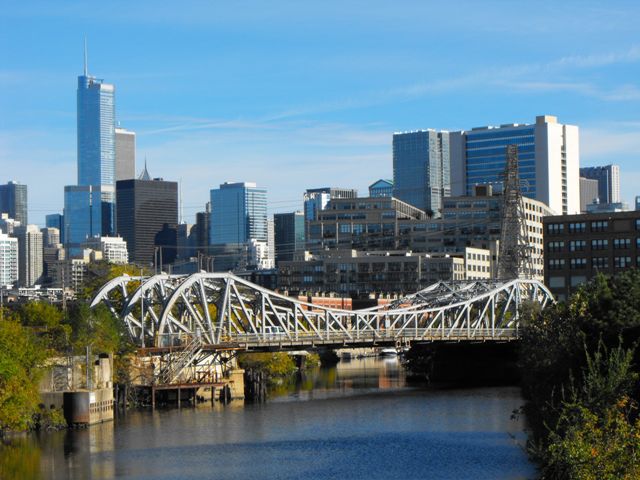
Primary Photographer(s): Nathan Holth
Bridge Documented: August 12, 2006 and October 2010
Chicago: Cook County, Illinois: United States
Metal Rivet-Connected Pratt Through Truss, Movable: Double Leaf Bascule (Fixed Trunnion) and Approach Spans: Metal Stringer (Multi-Beam), Fixed
1909 By Builder/Contractor: Jules E. Roemheld Company and Engineer/Design: City of Chicago
Not Available or Not Applicable
206.0 Feet (62.8 Meters)
302.0 Feet (92 Meters)
36 Feet (10.97 Meters)
1 Main Span(s) and 4 Approach Span(s)
16602226640

View Information About HSR Ratings
Bridge Documentation
This bridge no longer exists!
View Archived National Bridge Inventory Report - Has Additional Details and Evaluation
View Historic American Engineering Record (HAER) Documentation For This Bridge
HAER Data Pages, PDF
View A Selection of the Original Plan Sheets For This Historic Bridge
This extremely early and rare historic bridge was demolished by Chicago Department of Transportation January 2011!
Heritage At Great Risk
HistoricBridges.org has normally considered Chicago to have one of the strongest commitments to historic bridges seen in any large city in North America. Chicago has chosen to preserve, maintain, and rehabilitate many of its historic movable bridges. However this exemplary track record is beginning to develop a serious crack, since with the exception of the Cortland Street Bridge, there appears to be a trend to demolish all of Chicago's earliest bascule bridges with the exception of the Cortland Street Bridge. With the North Avenue Bridge demolished, this Halsted Street Bridge demolished, and the only other two bridges from this generation of bridge remaining in Chicago appearing to be in need of paint with no recent signs of rehabilitation visible, Chicago is at risk for losing one of the most important groups of historic bridges in the city. While the preservation of the nationally significant Cortland Street Bridge is to be applauded, the preservation of these earliest (pre-1910) bascule bridges should not be limited to a single example. Worse, when Chicago does choose to demolish these bridges, there is no effort to reincorporate the original materials into the replacement bridge. Instead, Chicago chooses to construct bizarre looking ultra-modern bridges that have no heritage value whatsoever and offer no interpretation of the history that has been lost. Furthermore, these bridges do not fit with Chicago, which is a city that has a stronger connection to historic structures than it does modern structures (particularly in the context of its bridges), one of the reasons why heritage tourism is a significant part of Chicago's economy. A better solution, which would better coexist with Chicago's rich atmosphere of heritage, would be to place the historic trusses of the bascule bridge onto a replacement bridge as decorations. This has been done successfully with truss bridges elsewhere.
The replacement bridge is shown below. As is clearly visible, the bridge looks nothing like the historic bridge, nor could it reasonably be described as "context sensitive" since its overly modern appearance conflicts with the broad, diverse collection of historic bridges in Chicago. The bridge looks out of place and inappropriate among the collection of Chicago bridges. To further the case, consider the new light posts installed along Halsted Street at the same time this bridge was built. This new lighting is a historical style, with a very ornate and detailed appearance. This style of lighting would go nicely with any historic bridge in Chicago, or alongside the many historic buildings in the city as well. However, the lights really do not go well with the extremely modern and simple appearance of the replacement bridge.

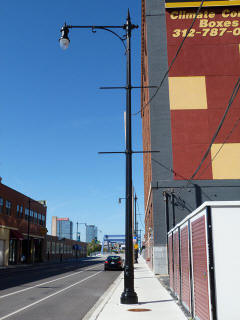
About This Bridge
This bridge was the eighth bridge built to the first bascule bridge design seen in Chicago. Note that there are not eight bridges of this design remaining in Chicago however, due to demolition of bridges like the North Avenue Bridge. The superstructure for this bridge was built by the Jules E. Roemheld Company, and the substructure was built by the Fitzsimons and Connell Company both of Chicago. Both the period in which this bridge was built as well as the complexity of a movable bridge both suggest that a bridge like this would have been designed by an outside consulting engineer or bridge company. However, Chicago engineers were very skilled and creative and normally took the lead in the design of the city's movable bridges, often to the chagrin of bridge companies run by well-known engineers such as Joseph Strauss. Indeed, this Halsted Street Bridge is one such example of the City of Chicago's engineering team which was spearheaded by City Engineer John E. Ericson. Chicago played a leading role in the development of what is the most common and perhaps most versatile type of movable bridge, the bascule bridge type. As an early, prototypical example of the Chicago trunnion bascule that would be influential to bridge construction nationwide, this bridge should be considered to have national significance, along with all surviving first generation bascule bridges in Chicago.
The substructure of this bridge was built by February 1, 1908 while the superstructure erection had begun on December 10, 1907. The superstructure was completed and the bridge opened to traffic on November 4, 1908. Each leaf of this bridge as originally built was powered by two 40 horsepower electric motors. The substructure cost $88,742.75 and the superstructure cost $159,240.00 with a complete cost of $247,982.75.
The Historic American Engineering Record documentation for this bridge mentions that this bridge, when built, had a "displayed an aesthetic concern that was totally lacking." While the large, truss-filled bridge might have been considered an eyesore back in the early 20th century, today the bridge can be considered very beautiful and certainly eye catching for its unique appearance composed of curves and angles that are unlike those found on any other bridge type. In a world where simplicity and lack of aesthetic concern is the order of the day in modern bridge design, this bridge displays a complex geometric art not seen even in the so-called aesthetic North Avenue Bridge replacement. From the curved shape of the overall bridge, to the truss configurations, to the extensive v-lacing and lattice on this bridge's built-up beams, the complexity is evident. As one of the largest of this early bascule design seen in Chicago, the bridge is even more impressive. While the complexity and massive design of the trusses might have not looked as good in a 1900s city filled with similar industrial features, today, the bridge stands out as a complex and intricate work of art compared to the simple concrete and steel beam bridges built today. Further, the bridge actually did try to incorporate some design features to make the bridge more aesthetically pleasing to the people of the time. These designs today continue to add beauty to the bridge. The knee braces that are on the portal bracing overhead at each end of the bridge are curved and feature circle designs cut out of them. Also, the sway/portal bracing has an arched design on top as well.
Carnegie Steel marks were found on some of this bridge's steel indicating the source of at least some of the steel used in this bridge.
Ogden Avenue used to cross Goose Island via two bascule bridges. This viaduct was built many years after after the Halsted Street Bridge... yet demolished many years before the Halsted Street Bridge was replaced. It crossed the canal just west of this Halsted Street Bridge and passed over Halsted Street as it curved north. The demolition of the Art Deco influenced Ogden Viaduct also marked a major loss of Chicago heritage.
The previous bridge at this location was the first bridge at this location, and was built in 1874 as a hand-turned iron bridge by Fox and Howard. It was 228 feet long and 32 feet wide.
The below drawing was actually taken from the demolition plans for this bridge, but it has some of the parts of the bridge labeled, and so is included here for reference.
![]()
Historic Bridges of Chicago and Cook County


Chicago and Cook County are home to one of the largest collections of historic bridges in the country, and no other city in the world has more movable bridges. HistoricBridges.org is proud to offer the most extensive coverage of historic Chicago bridges on the Internet.
General Chicago / Cook County Bridge Resources
Chicago's Bridges - By Nathan Holth, author of HistoricBridges.org, this book provides a discussion of the history of Chicago's movable bridges, and includes a virtual tour discussing all movable bridges remaining in Chicago today. Despite this broad coverage, the book is presented in a compact format that is easy to take with you and carry around for reference on a visit to Chicago. The book includes dozens of full color photos. Only $9.95 U.S! ($11.95 Canadian). Order Now Direct From The Publisher! or order on Amazon.
Chicago River Bridges - By Patrick T. McBriarty, this is a great companion to Holth's book shown above. This much larger book offers an extremely in-depth exploration of Chicago's movable highway bridges, including many crossings that have not existed for many years. Order Now Direct From The Publisher! or order on Amazon.
View Historic American Engineering Record (HAER) Overview of Chicago Bascule Bridges (HAER Data Pages, PDF)
Chicago Loop Bridges - Chicago Loop Bridges is another website on the Internet that is a great companion to the HistoricBridges.org coverage of the 18 movable bridges within the Chicago Loop. This website includes additional information such as connections to popular culture, overview discussions and essays about Chicago's movable bridges, additional videos, and current news and events relating to the bridges.
Additional Online Articles and Resources - This page is a large gathering of interesting articles and resources that HistoricBridges.org has uncovered during research, but which were not specific to a particular bridge listing.
![]()
Photo Galleries and Videos: Halsted Street North Branch Canal Bridge
Structure Overview
Original / Full Size PhotosA collection of overview photos that show the bridge as a whole and general areas of the bridge. This gallery offers photos in the highest available resolution and file size in a touch-friendly popup viewer.
Alternatively, Browse Without Using Viewer
![]()
Structure Details
Original / Full Size PhotosA collection of detail photos that document the parts, construction, and condition of the bridge. This gallery offers photos in the highest available resolution and file size in a touch-friendly popup viewer.
Alternatively, Browse Without Using Viewer
![]()
Demolition and Replacement
Original / Full Size PhotosPhotos showing the demolition and photos showing the replacement bridge. This gallery offers photos in the highest available resolution and file size in a touch-friendly popup viewer.
Alternatively, Browse Without Using Viewer
![]()
Structure Overview
Mobile Optimized PhotosA collection of overview photos that show the bridge as a whole and general areas of the bridge. This gallery features data-friendly, fast-loading photos in a touch-friendly popup viewer.
Alternatively, Browse Without Using Viewer
![]()
Structure Details
Mobile Optimized PhotosA collection of detail photos that document the parts, construction, and condition of the bridge. This gallery features data-friendly, fast-loading photos in a touch-friendly popup viewer.
Alternatively, Browse Without Using Viewer
![]()
Demolition
Mobile Optimized PhotosPhotos showing the demolition and photos showing the replacement bridge. This gallery features data-friendly, fast-loading photos in a touch-friendly popup viewer.
Alternatively, Browse Without Using Viewer
![]()
Maps and Links: Halsted Street North Branch Canal Bridge
This historic bridge has been demolished. This map is shown for reference purposes only.
Coordinates (Latitude, Longitude):
Search For Additional Bridge Listings:
Bridgehunter.com: View listed bridges within 0.5 miles (0.8 kilometers) of this bridge.
Bridgehunter.com: View listed bridges within 10 miles (16 kilometers) of this bridge.
Additional Maps:
Google Streetview (If Available)
GeoHack (Additional Links and Coordinates)
Apple Maps (Via DuckDuckGo Search)
Apple Maps (Apple devices only)
Android: Open Location In Your Map or GPS App
Flickr Gallery (Find Nearby Photos)
Wikimedia Commons (Find Nearby Photos)
Directions Via Sygic For Android
Directions Via Sygic For iOS and Android Dolphin Browser
USGS National Map (United States Only)
Historical USGS Topo Maps (United States Only)
Historic Aerials (United States Only)
CalTopo Maps (United States Only)

